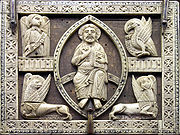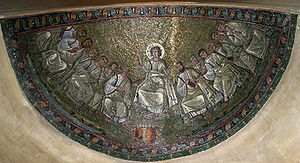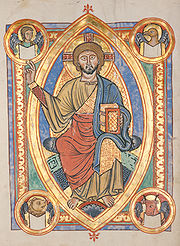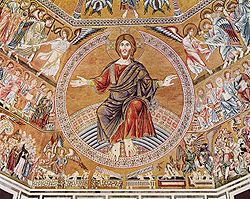
Christ in Majesty
Encyclopedia

Christ
Christ is the English term for the Greek meaning "the anointed one". It is a translation of the Hebrew , usually transliterated into English as Messiah or Mashiach...
seated on a throne as ruler of the world, always seen frontally in the centre of the composition, and often flanked by other sacred figures, whose membership changes over time and according to the context. The image develops from Early Christian art, which directly borrowed the formulae of depictions of the enthroned Roman Emperor
Roman Emperor
The Roman emperor was the ruler of the Roman State during the imperial period . The Romans had no single term for the office although at any given time, a given title was associated with the emperor...
. In the Byzantine
Byzantine art
Byzantine art is the term commonly used to describe the artistic products of the Byzantine Empire from about the 5th century until the Fall of Constantinople in 1453....
world, the image developed slightly differently into the half-length Christ Pantocrator
Christ Pantocrator
In Christian iconography, Christ Pantokrator refers to a specific depiction of Christ. Pantocrator or Pantokrator is a translation of one of many Names of God in Judaism...
, "Christ, Ruler of All", a usually unaccompanied figure, and the Deesis
Deesis
In Byzantine art, and later Eastern Orthodox art generally, the Deësis or Deisis , is a traditional iconic representation of Christ in Majesty or Christ Pantocrator: enthroned, carrying a book, and flanked by the Virgin Mary and St. John the Baptist, and sometimes other saints and angels...
, where a full-length enthroned Christ is entreated by Mary and St. John the Baptist, and often other figures. In the West, the evolving composition remains very consistent within each period until the Renaissance
Renaissance
The Renaissance was a cultural movement that spanned roughly the 14th to the 17th century, beginning in Italy in the Late Middle Ages and later spreading to the rest of Europe. The term is also used more loosely to refer to the historical era, but since the changes of the Renaissance were not...
, and then remains important until the end of the Baroque
Baroque
The Baroque is a period and the style that used exaggerated motion and clear, easily interpreted detail to produce drama, tension, exuberance, and grandeur in sculpture, painting, literature, dance, and music...
, in which the image is ordinarily transported to the sky.
Development of the image

Dais
Dais is any raised platform located either in or outside of a room or enclosure, often for dignified occupancy, as at the front of a lecture hall or sanctuary....
, often with his feet on a low stool and usually flanked by Saints Peter
Saint Peter
Saint Peter or Simon Peter was an early Christian leader, who is featured prominently in the New Testament Gospels and the Acts of the Apostles. The son of John or of Jonah and from the village of Bethsaida in the province of Galilee, his brother Andrew was also an apostle...
and Paul, and in a larger composition the other apostles. The central group of the Sarcophagus of Junius Bassus
Sarcophagus of Junius Bassus
The Sarcophagus of Junius Bassus is a marble Early Christian sarcophagus used for the burial of Junius Bassus, who died in 359. It has been described as "probably the single most famous piece of early Christian relief sculpture." The sarcophagus was originally placed in or under Old St...
of 359 (Vatican
Vatican Museums
The Vatican Museums , in Viale Vaticano in Rome, inside the Vatican City, are among the greatest museums in the world, since they display works from the immense collection built up by the Roman Catholic Church throughout the centuries, including some of the most renowned classical sculptures and...
) is the earliest example with a clear date. In some cases Christ hands a scroll
Scroll
A scroll is a roll of parchment, papyrus, or paper, which has been drawn or written upon.Scroll may also refer to:*Scroll , the decoratively curved end of the pegbox of string instruments such as violins...
to St Peter on his right, imitating a gesture often made by Emperors handing an Imperial decree to a minister, as in ivory consular diptych
Diptych
A diptych di "two" + ptychē "fold") is any object with two flat plates attached at a hinge. Devices of this form were quite popular in the ancient world, wax tablets being coated with wax on inner faces, for recording notes and for measuring time and direction.In Late Antiquity, ivory diptychs with...
s, on the Arch of Constantine
Arch of Constantine
The Arch of Constantine is a triumphal arch in Rome, situated between the Colosseum and the Palatine Hill. It was erected to commemorate Constantine I's victory over Maxentius at the Battle of Milvian Bridge on October 28, 312...
, and the Missorium of Theodosius I
Missorium of Theodosius I
The Missorium of Theodosius I is a large ceremonial silver dish preserved in the Real Academia de la Historia, in Madrid, Spain. It was probably made in Constantinople for the tenth anniversary in 388 of the reign of the Emperor Theodosius I, the last Emperor to rule both the Eastern and Western...
. This depiction is known as the Traditio legis ("handing over the law"), or Christ the lawgiver - "the apostles are indeed officials, to whom the whole world is entrusted" wrote Saint John Chrysostom
John Chrysostom
John Chrysostom , Archbishop of Constantinople, was an important Early Church Father. He is known for his eloquence in preaching and public speaking, his denunciation of abuse of authority by both ecclesiastical and political leaders, the Divine Liturgy of St. John Chrysostom, and his ascetic...
. This depiction tends to merge into one of "Christ the teacher", which also derives from classical images of bearded philosophers.
Other Imperial depictions of Christ, standing as a triumphing general, or seated on a ball representing the world, or with different companions, are found in the next centuries. By the seventh century the Byzantine Christ Pantocrator holding a book representing the Gospel
Gospel
A gospel is an account, often written, that describes the life of Jesus of Nazareth. In a more general sense the term "gospel" may refer to the good news message of the New Testament. It is primarily used in reference to the four canonical gospels of Matthew, Mark, Luke, and John...
s and raising his right hand has become essentially fixed in the form it retains in Eastern Orthodoxy today. "Christ Triumphant" had a separate future development, usually standing, often with both hands raised high.

Apse
In architecture, the apse is a semicircular recess covered with a hemispherical vault or semi-dome...
of many, if not most, decorated churches. A full-length figure would need to be greatly reduced for the head to make maximum impact from a distance (because of the flattening at the top of the semi-dome). The gesture Christ makes has become one of blessing, but is originally an orators gesture of his right to speak. The Deesis became standard at the centre of the templon
Templon
A templon is a feature of Byzantine churches consisting of a barrier separating the nave from the sacraments at the altar....
beam in Orthodox
Eastern Orthodox Church
The Orthodox Church, officially called the Orthodox Catholic Church and commonly referred to as the Eastern Orthodox Church, is the second largest Christian denomination in the world, with an estimated 300 million adherents mainly in the countries of Belarus, Bulgaria, Cyprus, Georgia, Greece,...
churches and the templon's successor, the iconostasis
Iconostasis
In Eastern Christianity an iconostasis is a wall of icons and religious paintings, separating the nave from the sanctuary in a church. Iconostasis also refers to a portable icon stand that can be placed anywhere within a church...
, and is also found as a panel icon
Icon
An icon is a religious work of art, most commonly a painting, from Eastern Christianity and in certain Eastern Catholic churches...
. Generally the Pantocrator has no visible throne, but the earlier Deesis does, and at least a single-step dais. The Deesis continues to appear in Western art, but not as often or in such an invariable composition as in the East.

Four Evangelists
In Christian tradition the Four Evangelists are Matthew, Mark, Luke, and John, the authors attributed with the creation of the four Gospel accounts in the New Testament that bear the following titles:*Gospel according to Matthew*Gospel according to Mark...
, representing the vision of Chapters 4 and 5 of the Book of Revelation
Book of Revelation
The Book of Revelation is the final book of the New Testament. The title came into usage from the first word of the book in Koine Greek: apokalupsis, meaning "unveiling" or "revelation"...
. In the Romanesque
Romanesque art
Romanesque art refers to the art of Western Europe from approximately 1000 AD to the rise of the Gothic style in the 13th century, or later, depending on region. The preceding period is increasingly known as the Pre-Romanesque...
period the twenty-four elder
Elder (Christianity)
An elder in Christianity is a person valued for his wisdom who accordingly holds a particular position of responsibility in a Christian group. In some Christian traditions an elder is a clergy person who usually serves a local church or churches and who has been ordained to a ministry of Word,...
s of the Apocalypse
Book of Revelation
The Book of Revelation is the final book of the New Testament. The title came into usage from the first word of the book in Koine Greek: apokalupsis, meaning "unveiling" or "revelation"...
are often seen. Christ also holds a book and makes the blessing gesture, no doubt under Byzantine influence. In both, Christ's head is surrounded by a crossed halo
Halo (religious iconography)
A halo is a ring of light that surrounds a person in art. They have been used in the iconography of many religions to indicate holy or sacred figures, and have at various periods also been used in images of rulers or heroes...
. In Early Medieval Western art the image was very often given a full page in illuminated
Illuminated manuscript
An illuminated manuscript is a manuscript in which the text is supplemented by the addition of decoration, such as decorated initials, borders and miniature illustrations...
Gospel Book
Gospel Book
The Gospel Book, Evangelion, or Book of the Gospels is a codex or bound volume containing one or more of the four Gospels of the Christian New Testament...
s, and in metalwork or ivory on their covers, and it remained very common as a large-scale fresco in the semi-dome of the apse in Romanesque
Romanesque architecture
Romanesque architecture is an architectural style of Medieval Europe characterised by semi-circular arches. There is no consensus for the beginning date of the Romanesque architecture, with proposals ranging from the 6th to the 10th century. It developed in the 12th century into the Gothic style,...
churches, and carved in the tympanum
Tympanum (architecture)
In architecture, a tympanum is the semi-circular or triangular decorative wall surface over an entrance, bounded by a lintel and arch. It often contains sculpture or other imagery or ornaments. Most architectural styles include this element....
of church portals. This "seems to have been almost the only theme of apse
Apse
In architecture, the apse is a semicircular recess covered with a hemispherical vault or semi-dome...
-pictures" in Carolingian
Carolingian
The Carolingian dynasty was a Frankish noble family with origins in the Arnulfing and Pippinid clans of the 7th century AD. The name "Carolingian", Medieval Latin karolingi, an altered form of an unattested Old High German *karling, kerling The Carolingian dynasty (known variously as the...
and Ottonian
Ottonian
The Ottonian dynasty was a dynasty of Germanic Kings , named after its first emperor but also known as the Saxon dynasty after the family's origin. The family itself is also sometimes known as the Liudolfings, after its earliest known member Liudolf and one of its primary leading-names...
churches, all of which are now lost, although many examples from the period survive in illuminated manuscript
Illuminated manuscript
An illuminated manuscript is a manuscript in which the text is supplemented by the addition of decoration, such as decorated initials, borders and miniature illustrations...
s.
From the Romanesque period, the image in the West often began to revert to the earliest, more crowded conception, and archangel
Archangel
An archangel is an angel of high rank. Archangels are found in a number of religious traditions, including Judaism, Christianity and Islam. Michael and Gabriel are recognized as archangels in Judaism and by most Christians. Michael is the only archangel specifically named in the Protestant Bible...
s, apostles and saints, now often all facing inwards towards Christ, appear, as well as the beasts emblematic of the Evangelists and the twenty-four elders. This development paralleled the movement towards a more "realistic" depiction of the "heavenly court" seen in the increasingly popular subjects of the Maestà
Maestà
Maestà, the Italian word for "majesty", designates an iconic formula of the enthroned Madonna with the child Jesus, whether or not accompanied with angels and saints...
(the enthroned Virgin and Child) and the Coronation of the Virgin
Coronation of the Virgin
The Coronation of the Virgin or Coronation of Mary is a subject in Christian art, especially popular in Italy in the 13th to 15th centuries, but continuing in popularity until the 18th century and beyond. Christ, sometimes accompanied by God the Father and the Holy Spirit in the form of a dove,...
by Christ.
A Christ in Majesty became standard carved in the tympanum of a decorated Gothic
Gothic architecture
Gothic architecture is a style of architecture that flourished during the high and late medieval period. It evolved from Romanesque architecture and was succeeded by Renaissance architecture....
church portal, by now surrounded by a large number of much smaller figures around the archivolt
Archivolt
An archivolt is an ornamental molding or band following the curve on the underside of an arch. It is composed of bands of ornamental moldings surrounding an arched opening, corresponding to the architrave in the case of a rectangular opening...
s. In painting, the Ghent Altarpiece
Ghent Altarpiece
The Ghent Altarpiece or Adoration of the Mystic Lamb is a very large and complex Early Netherlandish polyptych panel painting which is considered to be one of Belgium's masterpieces and one of the world's treasures.It was once in the Joost Vijdt chapel at Saint Bavo Cathedral, Ghent, Belgium, but...
is the culmination of the Gothic image, although a minority of art historians believe that in this case it is God the Father
God the Father
God the Father is a gendered title given to God in many monotheistic religions, particularly patriarchal, Abrahamic ones. In Judaism, God is called Father because he is the creator, life-giver, law-giver, and protector...
, not Christ, who is shown in majesty.
Christ in Judgement

Hell
In many religious traditions, a hell is a place of suffering and punishment in the afterlife. Religions with a linear divine history often depict hells as endless. Religions with a cyclic history often depict a hell as an intermediary period between incarnations...
on the right and the righteous on the left (at Christ's right-hand side) rising up to Heaven
Heaven
Heaven, the Heavens or Seven Heavens, is a common religious cosmological or metaphysical term for the physical or transcendent place from which heavenly beings originate, are enthroned or inhabit...
. Generally Christ still looks straight forward at the viewer, but has no book; he often gestures with his hands to direct the dammed downwards, and the saved up.
From the High Renaissance
High Renaissance
The expression High Renaissance, in art history, is a periodizing convention used to denote the apogee of the visual arts in the Italian Renaissance...
the subject was more loosely treated; Christ and his court take to the clouds, and are distributed with an eye to a harmonious and "natural" composition rather than the serried ranks of old. From the late Renaissance and through the Baroque, it often forms the upper part of a picture depicting events on earth in the lower register, and as stricter perspective replaces the hieratic scaling of the Middle Ages, Christ becomes literally diminished. Such depictions tend not to be described as "Christ in Majesty", although they are the linear development of the earlier image; the main subject has become the human events in the foreground, such as the martyrdom of a saint, to which Christ is now a rather distant witness.
External links
- http://commons.wikimedia.org/wiki/Majestas_Domini
- http://commons.wikimedia.org/wiki/Reliefs_of_Majestas_Domini
- Christ in Majesty
- (Getty Museum,); Christ in Majesty, manuscript illumination, German, (Hildesheim), about 1170s
- Christ in Majesty, with apocalypse details: chancelk painting, Kempley, Gloucestershire c.1120
- Christ in Majesty: illumination in the Aberdeen Bestiary, late twelfth century
- Definition of Deesis -- Includes photos of the Deesis in the Hagia SophiaHagia SophiaHagia Sophia is a former Orthodox patriarchal basilica, later a mosque, and now a museum in Istanbul, Turkey...
.

